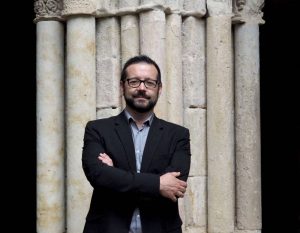People, landscape and heritage are the pillars that inform the work of Fundación Santa María la Real in Spain. Created in 1977 to promote the restoration of Santa María la Real Monastery, they have recently accelerated their commitments to develop activities to generate a cultural and environmental impact.
As Alliance magazine’s June 2021 issue looks at climate philanthropy ahead of COP26 in Glasgow, we partnered with the International Philanthropy Commitment on Climate Change to ask a number of organisations around the world: what is philanthropy’s role in addressing climate change at this critical moment?
Director, Álvaro Retortillo Osuna, joined Alliance to talk about the work of Fundación Santa María la Real.
 Alliance and IPCCC: Has your organisation made any commitment to climate action or joined a climate pledge? If so, what?
Alliance and IPCCC: Has your organisation made any commitment to climate action or joined a climate pledge? If so, what?
The strongest commitment that our Foundation has undertaken with the climate action is the reduction of 14 per cent of the Carbon Footprint in three years’ time. This commitment was accompanied by the execution of an environmental awareness campaign for the employees, the analysis of work processes and the implementation of good practices in the entity’s environmental management. At the same time, we are part of social initiatives for environmental protection, such as the Climate Pact of Spanish Foundations. Our mission is to achieve the sustainable development of the territories, both in urban as in rural areas, and this is not possible without an environmental awareness that avoids the waste of resources and the pollution of the planet.
What encouraged your organisation to start its climate journey?
Besides people and heritage, landscape has always been part of our entity’s mission. We have always defended that the sustainable development of territories has to be built on the basis of the People – Landscape – Heritage trinomial, where the landscape influences and is influenced by society, generating a unique landscape and culture both on a material and immaterial level.
With this particular view of the landscape and, therefore, the environment in general, we have always kept in mind that, in addition to the social and economic impact, we must ensure the cultural and environmental impact, without any of the interests coming into conflict.
Can you share an example of the changes that your organisation has made in its embrace of climate work?
Once the Foundation decided to bet on the climate challenge, the necessary resources were provided so that the Projects and Innovation Office could dedicate itself to developing activities in this area. Since then, we have worked to transparently communicate the environmental impact of our activities, information pills are shared regularly with more than 250 workers, good environmental management practices are periodically updated and the consumption of plastics has been eliminated in all offices. One of the best management practices was the substitution of the fossil fuel boiler in one of the residences for the elderly by a biomass boiler. This was carried out using an Energy Services Contract. With an average use of 417.5 MWh, this means a yearly saving of 148.5 tons in CO2 emissions. It was the great starting point in saving resources and reducing emissions, as a result of which new improves with facilities and equipment occurred.
In this key decade for climate action, many are recognising the intersection of climate with other areas of work. How are you integrating a climate lens into your other focus areas?
It is true that the climate issue was seen as something that affected the commitments of governments and large companies some years ago, but energy transition policies as a cross-cutting issue are having impact on all kinds of activities. We carry out cultural activities, training for employment, entrepreneurship, care for the elderly, cultural trips, publishing, etc. where it is always possible to design and implement small good practices for saving resources, avoiding unnecessary emissions. What is really important is that the participants in these activities also perceive them, encouraging the entire value chain to engage with the climate issue.
Has your work in the climate sphere inspired you to change the way you are investing your endowment? Why or why not?
The R&D projects in which we invest have taken on a much more sustainable component, where resources efficiency, climate change and the sustainability of products and services are always present. Preventive conservation is studied associating it with comfort and consumption in projects such as EnerCon2, at INUNDATIO we take advantage of Big Data and AI to prevent and minimize climate risks, and in the restoration and reuse of heritage we add Nature Based Solutions and recycled materials or materials from the circular economy, as in the case of Raíces de Barrio project.
In our employment and entrepreneurship projects we have added different training contents related to the Green Deal, the SDGs, the climate challenge, the energy transition or the circular economy. We include success stories from companies that have opted for the environmental sector and we collaborate with entrepreneurs who have reinvented the way of doing things. Our goal is to add value and create synergies between employment and the environmental sector, making the climate challenge a unique opportunity. This has allowed us to consolidate a working line specialized in current issues of environmental sustainability and climate challenge.
What kind of impact have you seen your climate focus having already? If you have a story, please share it.
At the headquarters, we have large office spaces with many workstations. We optimised the heating system distribution with an improved distribution of working places. This allowed the reduction of heating use in a part of the building. The natural gas use in the autumn-winter season has decreased from 147386 kWh to 87347 kWh, which caused a reduction of 10.2 CO2 tons emissions.
What are some of the challenges you have encountered so far in your climate work?
The Foundation’s greatest challenge to achieve climate-neutral lies in the adaptation of some old facilities and buildings, which require some moderate-large investments. However, the most passionate challenge for us is about raising awareness among the workers and collaborators themselves, as we know that it is in people where the power of change is truly concentrated.
How did your organisation convince its board to take on climate work or applying a climate lens framing to work in other areas?
The climate issue gradually gained more power and more presence in the Foundation hand in hand with European and national policies and initiatives (SDGs, Green Deal, Circular Economy Strategy, Just Transition, etc.) and also hand in hand with new generations committed to the cause. Our Foundation own culture encourages sustainable territorial development, which is why the Management Board always supports initiatives that promote it. Furthermore, we are applying a climate lens in many of the projects that we run in other fields. For instance, we are promoting a national network to transform the energy transition as an opportunity to foster labour and social inclusion of vulnerable groups.
Do you think philanthropic foundations should be held to account for their climate commitments, such as with an independent climate action tracker? Why or why not?
Yes. I think it should be mandatory to measure the impact of our activities, since the simple calculation process is surprisingly revealing, being the best awareness tool you can use. I am convinced that, once you do it for the first time, you commit to continuous improvement for coming years and the climate issue becomes a key part of the culture of the entities.
Do you have any advice to share with other foundations embarking on their own climate journey?
I would start by dedicating just one day to observe the most everyday basic practices and processes of the entity to find in them the weak points and needed motivation. Next, I would assemble a diverse team of people committed to the cause, and from there, I would work on identifying points for continuous improvement and establishing an impact measurement system. Everything else comes by itself.







Comments (1)
Giwa Community Response is a newly formed Community Based Organization that focuses on environmental Conservation, tree planting, street / slum cleaning, and river cleanup every first Sunday of the Month in Nyeri County - Kenya. As this involves about 75 volunteers, we are still facing some challenges like resources to buy more protective items; gumboots, gloves, branded t-shirts, garbage bags, and tree-seedlings. It's our humble request for any financial assistance or partnership to make this project successful. Regards,